Harpists by Puget Sound Students Christina Sumprer, Frances Welsh and Rosalie Boyle
Friday, December 2nd
3-3:20 p.m.
West Reading Room,
Collins Library
For more information contact: libref@pugetsound.edu
Harpists by Puget Sound Students Christina Sumprer, Frances Welsh and Rosalie Boyle
Friday, December 2nd
3-3:20 p.m.
West Reading Room,
Collins Library
For more information contact: libref@pugetsound.edu
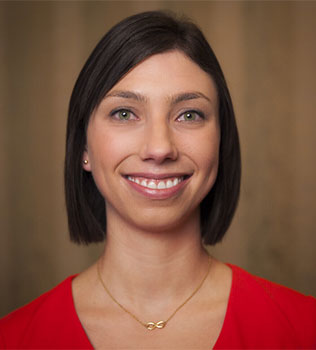 On October 7, Nicole Allen, Scholarly Publishing and Academic Resources Coalition (SPARC) Director of Open Education, led a discussion about open education resources at the University of Puget Sound. An alumna of Puget Sound, Ms. Allen is an internationally recognized expert and leading voice in the movement for open education. While there was some range to the conversation related to the broad opportunities open educational resources allow, textbooks were certainly the main topic.
On October 7, Nicole Allen, Scholarly Publishing and Academic Resources Coalition (SPARC) Director of Open Education, led a discussion about open education resources at the University of Puget Sound. An alumna of Puget Sound, Ms. Allen is an internationally recognized expert and leading voice in the movement for open education. While there was some range to the conversation related to the broad opportunities open educational resources allow, textbooks were certainly the main topic.
While there was a healthy turnout to the discussion, not every interested party on campus was able to attend. Below are some resources that were mentioned during the discussion and/or are useful resources that address topics from the discussion.
Based at the University of Minnesota, The Open Textbook Network (OTN) promotes access, affordability, and student success through the use of open textbooks.
Review of empirical research on the impacts of OER adoption produced by John Hilton III of the Open Education Group (originally published in Educational Technology Research and Development). Acts as a living annotated bibliography of articles about efficacy and/or perception of OER adoption.
Textbook Affordability Student Toolkit
Produced by Open Oregon for a conference of student leaders from Oregon’s community colleges, this toolkit is a useful primer for students and others. It focuses on the cost of textbooks, and includes some striking statistics. According to the GAO, textbook prices rose 82 % between 2002 and 2012, and study by PIRG found that 65% have skipped acquiring a course textbook due to cost.
Carnegie Mellon University Open Learning Initiative
The Open Learning Initiative (OLI) is a grant-funded group at Carnegie Mellon University, offering innovative online courses to anyone who wants to learn or teach. Our aim is to create high-quality courses and contribute original research to improve learning and transform higher education.
By Ben Tucker
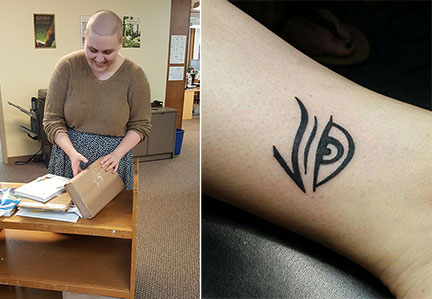 Autumn Raw works in Resource Management Services as an Acquisitions Assistant. This position assists the acquisitions supervisor with placing firm orders for library materials, preorder searches the catalog for order requests before placing the order, and unpacks and processes invoices for new materials.
Autumn Raw works in Resource Management Services as an Acquisitions Assistant. This position assists the acquisitions supervisor with placing firm orders for library materials, preorder searches the catalog for order requests before placing the order, and unpacks and processes invoices for new materials.
How would you describe your job?
In practical terms I process the new material that arrives every single day to the library, but in realistic terms I: open packages, sustain several paper cuts, wrestle with cardboard boxes, and scare myself when I accidentally pop the bubble wrap. For a job at the library it is quite physical, but that’s probably just because I have weak arms, and cardboard boxes can be tricky. One of the best parts of this job though is that I see a book from the instant a professor requests it, to when it arrives and is officially invoiced. There’s just something that is so neat about seeing a title on the screen, and then actually holding the physical book in my hand.
What do you like best about working in Collins Library?
The people I work with are who make this job so much fun to do, because although it can seem tedious at times, the general atmosphere and interactions are enough to bolster a waning attitude. I’ve some of the nicest people working at the library, and some days coming to work is the actual highlight of my day. The people here are witty, caring, and in general promote an inclusive and kind atmosphere that is great to be a part of!
What’s your favorite childhood book?
When I was younger I was completely obsessed with “A Series of Unfortunate Events” by Lemony Snicket. I was really morbid for a little kid from suburban Minnesota. Around the same time I started to read Snicket I was also getting into Edgar Allen Poe, and the two just fit hand-in-hand. “A Series” is this perfect blend of dark humor, romance, and absurdist horror that was unlike anything I had read at the time, and still haven’t yet really found in other novels. Neil Gaiman comes quite close, but otherwise this series stands alone.
As I’ve grown older, and begun to do some writing of my own, this series still has quite the effect on me. Before I turned 18 I knew that I wanted a tattoo, but for a while was unsure about just what I wanted. Didn’t take long, however, to think that the perfect first tattoo would be a homage to the series that dominated my childhood, and continues to still inspire me. The main villain of the series, Count Olaf, has a tattoo of an eye above his left ankle, and I followed suit. For the most part I have to briefly explain it (I don’t get that far before the person recognizes the allusion. Typically the ones who recognize it the quickest are the ones my age), but it’s always so great when someone sees the tattoo and immediately recognizes it!
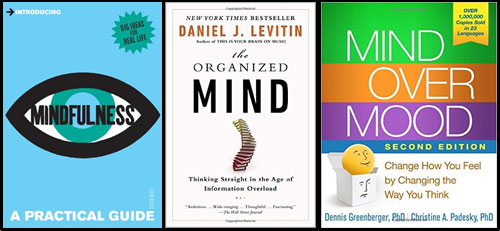 Greetings, Loggers! The Pacific Northwest winter is almost upon us. Projects, deadlines, and final exams approach. Right now, you may be wondering how to keep your sanity as you tackle the rest of the semester or if the sun will ever shine again – this time of year can be gloomy and stressful. Don’t let “Gloom-vember” get you down! Remember, it’s ok to press pause and take a break to re-charge your creative energy.
Greetings, Loggers! The Pacific Northwest winter is almost upon us. Projects, deadlines, and final exams approach. Right now, you may be wondering how to keep your sanity as you tackle the rest of the semester or if the sun will ever shine again – this time of year can be gloomy and stressful. Don’t let “Gloom-vember” get you down! Remember, it’s ok to press pause and take a break to re-charge your creative energy.
Managing your time, practicing self-care, and handling stress effectively will help improve your mood and your academic performance. In addition to providing practical information about other topics, the Life Skills Collection at Collins Library has many resources to help you get organized, stay positive, and prevent anxiety at the busiest times of your academic life. Here are our top picks to beating stress this November!
These resources (and many more) will help you balance your obligations without comprising your mental health. Don’t wait to seek out the support you need to excel this semester. Maintain a positive outlook by practicing self-care, knowing your resources, and taking a break (they’re good for you!).
The Life Skills Collection is located in the Learning Commons, on the first floor of Collins Library. Learn more on the companion guide devoted to the Life Skills Collection and discover many more resources at the University of Puget Sound!
By Katy Curtis, Humanities Librarian
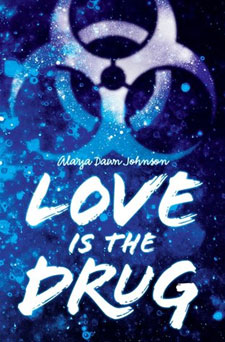 After meeting with a homeland security officer at a party, Emily Bird wakes up in a hospital with no memory of the previous few days. Her parents may be responsible for a deadly outbreak of a flu virus, her future goals are in jeopardy, her perfect boyfriend pales in comparison to homeland security officer Roosevelt David, and the school’s drug dealer is a genius and her new best friend. Together, Emily and Coffee fight for a way to unlock her memory, which may reveal the biggest government scandal in US history.
After meeting with a homeland security officer at a party, Emily Bird wakes up in a hospital with no memory of the previous few days. Her parents may be responsible for a deadly outbreak of a flu virus, her future goals are in jeopardy, her perfect boyfriend pales in comparison to homeland security officer Roosevelt David, and the school’s drug dealer is a genius and her new best friend. Together, Emily and Coffee fight for a way to unlock her memory, which may reveal the biggest government scandal in US history.
Find Love is the Drug and other fun reads in the Popular Reading Collection today!
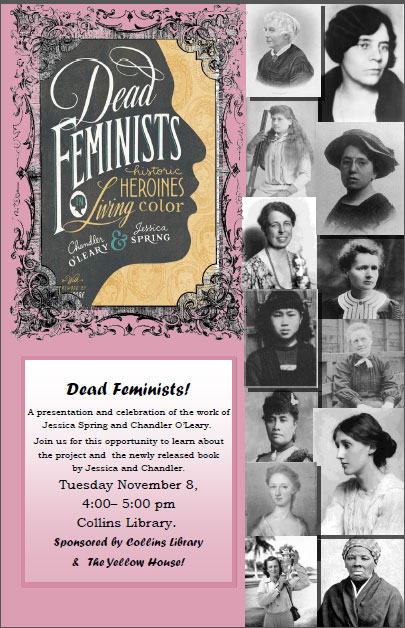 Join us for this opportunity to learn about the project and the newly released book by Jessica and Chandler.
Join us for this opportunity to learn about the project and the newly released book by Jessica and Chandler.
Tuesday, November 8
4:00– 5:00 pm
Collins Library
Sponsored by Collins Library & The Yellow House!
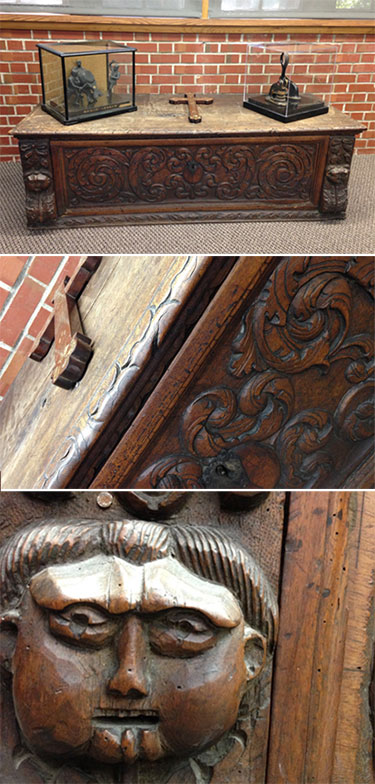 HAPPY HALLOWEEN LOGGERS!!! We here at Collins hope you had a fang-tastic holiday!
HAPPY HALLOWEEN LOGGERS!!! We here at Collins hope you had a fang-tastic holiday!
Now, the Archives & Special Collections is not known for being a spooky place, but perhaps it should be. Little do people know, among the dusty old books and cobwebbed shelves (just kidding, but seriously, we need more visitors) lurks a mystery that has yet to be solved. Deep in the Shelmidine room lies a chest, and not your ordinary chest. This chest is human-sized, extremely heavy, and has yet to be opened. The last time the contents of this monstrous beast saw the light of day remains a complete mystery to all of us, along with how it was sealed so impossibly well, and the weight of it proves it is NOT empty. We here in the Archives & Special Collections have all had a hand in trying to break the seal, but it has proven to be a real pain in the neck. Us librarians are known for being a cautious type, and so we’ve taken the necessary precautions to protect our dear books (and blood) from the potential dangers that lurk within.
That being said, if you’re short on candy this year I am here to supply you with a stash of Halloween treats that are sure to get under your trick-or-treaters’ skin! Tell some of these and you’re guaranteed not to get any boos from your audience! Have a spooktacular Halloween!
What’s a vampire’s favorite fruit?
A neck-tarine!
What do you get if you divide a pumpkin’s circumference by its diameter?
Pumpkin Pi!
How do monsters know what the future holds for them?
They read their horror-scopes!
What happened when the werewolf swallowed a clock?
He got ticks!
Why would a vampire need cold medicine?
For their coffin!
The Archives & Special Collections is open on Tuesdays, Wednesdays, and Thursdays from 12:00-3:00 p.m. or by appointment.
By Monica Patterson
As always, come by the Archives & Special Collections! Maybe you’ll meet our blood-thirsty friend! I hope to see you goblins hobblin’ this way soon!
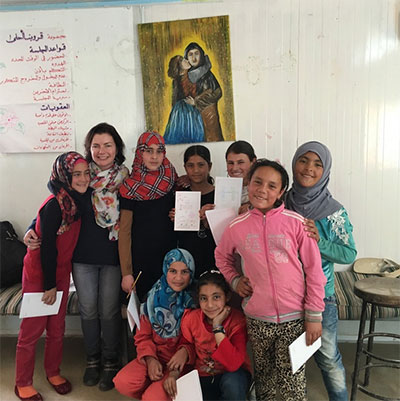 Recently, Karen, Fisher, UW Professor, visited the Library to share insights into her work with refugees. Below is a blog post by library employee, Carlisle Winifred Huntington.
Recently, Karen, Fisher, UW Professor, visited the Library to share insights into her work with refugees. Below is a blog post by library employee, Carlisle Winifred Huntington.
Creating Futures through Magical Devices and Library Caravans: Participatory Design with Syrian Youth at Za’atari Refugee Camp. http://syria.ischool.uw.edu/
I had the immense pleasure of listening in on Karen Fisher’s illuminating lecture about her work with Syrian youth at the Za’atari refugee camp in Jordan, hosted by the Collins Memorial Library. Karen E. Fisher is a professor at the Information School, as well as an adjunct professor of Communications at University of Washington. She has devoted her life to Humanitarian research and is especially passionate about developing ways in which HCI-industry-NGO collaborations can improve lives and build futures, starting with the young people at Za’atari.
Karen began her lecture by stating that the world is facing its worst refugee crisis since WWII. As of 2016, sixty five million refugees have been driven from their homes by war. Only one million of which are heading for Europe. In fact, 83% of all refugees will stay close to the centers of conflict, like those at Za’atari. The six years of war in Syria has brought forth 4.7 million new refugees and the numbers grow day by day. Za’atari is the second largest camp in the world, with a population of eighty three thousand people, most under the age of twenty five. In fact those most affected by the war and displacement are children and the elderly. Many young women are unable to attend attending school and getting an education, because once a wife, girls are forbidden to go to school due to household responsibilities. This kind of “information poverty”, as Karen called it, is rampant in the Za’atari camp. Although refugees are issued cellular devices, they are forbidden from accessing the Internet by the Jordanian government, as it could pose a security risk to the camp, as well as the surrounding area. As a result, many people in the camp are completely in the dark as to the goings on of life back home in Syria. Fisher describes how most refugees are desperate to know what life is like back home, where their family is, or how their property in Syria is fairing, if it is even still standing at all.
This why many refugees at Za’atari will treasure broken I-phones or tablets. Though the screen may be cracked or it may no longer have any cellular capabilities, the photos and the memories on the phones are priceless. One women in particular treasured a broken phone because it contained the only photo left of her dead son. The photo itself was a picture of her son’s body, and the phone was passed around the camp, searching for someone to identify him, until it finally reached his mother.
Despite the many grim realities these people have to face, there is still a never ending effort to keep hope alive in whatever way they can. Karen went on to describe one of the most impactful aspects of living at Za’atari camp was how nothing was ever wasted. Even the old tents were ripped apart and used as canvas to paint on. Artistic expression is a popular therapeutic tool for many of the refugees. Colorful murals and painted caravans can be found all over the camp, even the insides of people’s caravans are painted, often to resemble a lush green forest, creating an oasis in the harsh Jordan dessert. Being surrounded by color and beauty has been an immense comfort for the people living at Za’atari. Hope can also be found among the Syrian youth, whose imagination and creativity carries them through these difficult times. In one survey, Karen asked children to draw pictures of inventions they would want to create in order to make life easier at the camp. One little girl thought of magic glasses that could tell you what was wrong with a sick person and how to cure them, just by looking at them. Another thought of a robot to help the elderly. But one that struck Karen the most, was a depiction of two robots especially designed to create peace.
And therein lies the underlying desire that drives all refugees at Za’atari forward, the hope for peace. Despite all they have witnessed, all they have overcome, the people at Za’atari believe in peace, and believe that it is possible. And one way to help make that dream a reality is with the development of technology that allows all at Za’atari, though especially the youth, equal access to information and education. The development of libraries and other centers for learning at the refugee camp will be an enormous advancement in the lives of the young people affected by this global crisis. Because with knowledge, hopes and dreams can turn into tangible realities.
Note: The Collins Library staff with the assistance of community members and the University Bookstore collected art supplies, Karen Fisher took these supplies with her on her most recent trip to the Camp.
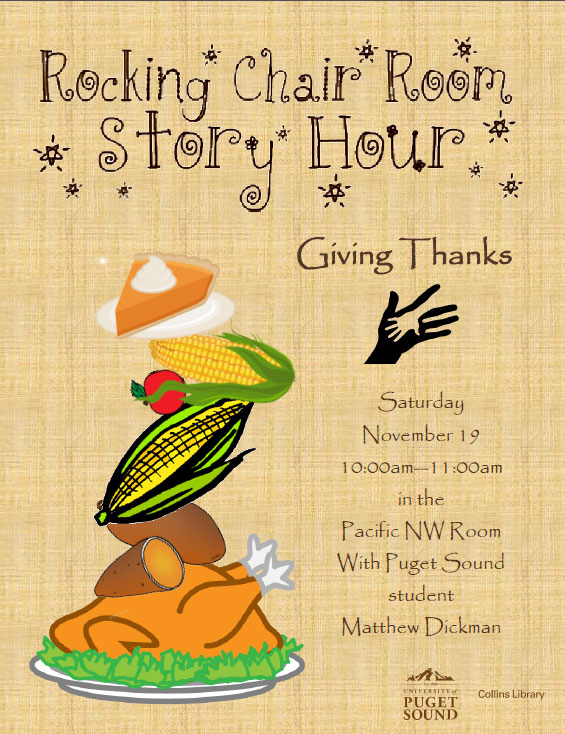 Saturday, November 12th
Saturday, November 12th
10:00am—11:00am
Pacific NW Room
This week’s Family Story Hour theme is giving Thanks and learning about Turkeys! Everyone will have the chance to make a turkey, set a Thanksgiving table and read some wonderful books about the season. Thanks are extended to all the terrific Puget Sound students who wake up early on Saturday mornings to greet our youngest readers!
A Bassoon Quartet by Puget Sound Students Aric MacDavid, Ethan Markowitz, Nicholas Navin, and Kelsey Tryon.
Friday, November 4th
3-3:20 p.m.
Reading Room, Collins Library
For more information contact: libref@pugetsound.edu